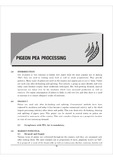Please use this identifier to cite or link to this item:
http://library.ediindia.ac.in:8181/xmlui//handle/123456789/2594Full metadata record
| DC Field | Value | Language |
|---|---|---|
| dc.contributor.author | Entrepreneurship Development Institute of India | - |
| dc.date.accessioned | 2016-01-13T05:05:54Z | - |
| dc.date.available | 2016-01-13T05:05:54Z | - |
| dc.date.issued | 2016-01-13 | - |
| dc.identifier.uri | http://hdl.handle.net/123456789/2594 | - |
| dc.description.abstract | Use of pulses is very common in Indian diet. Apart from the most popular use of making "Dal", they are used in making many food as well as snack preparations. They provide proteins. Many types of pulses are used in the country and pigeon pea is one of them. Pulses are used only after de-husking and splitting. This activity is going on since decades and even today some farmers employ these traditional techniques. But with growing demand, manual operations are taken over by the machines which have increased production as well as recovery. Per capita consumption of pulses in India is still very low and thus there is a need to increase it to ensure adequate intake of nutrients. | en_US |
| dc.description.sponsorship | Government of India, Ministry of Food Processing | en_US |
| dc.language.iso | en | en_US |
| dc.publisher | Entrepreneurship Development Institute of India | en_US |
| dc.title | Pigeon Pea Processing | en_US |
| dc.type | Other | en_US |
| Appears in Collections: | Ministry of Food Processing Industries | |
Files in This Item:
| File | Description | Size | Format | |
|---|---|---|---|---|
| 10 Pigeon Pea Processing.pdf | 116.11 kB | Adobe PDF |  View/Open |
Items in DSpace are protected by copyright, with all rights reserved, unless otherwise indicated.
